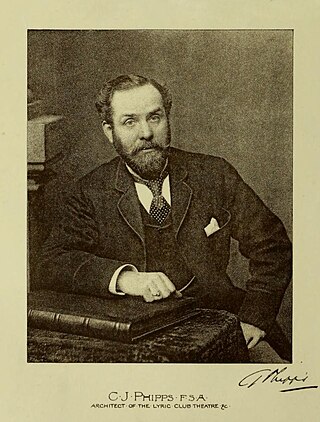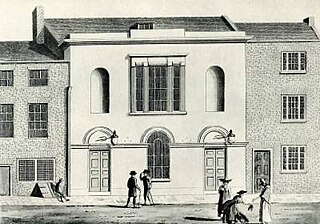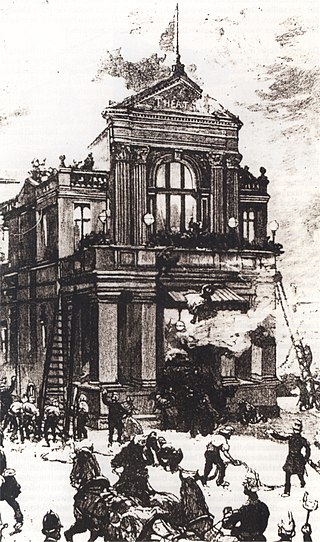Related Research Articles

The Iroquois Theatre fire occurred on December 30, 1903, at the Iroquois Theatre in Chicago. It is one of the deadliest single-building fires in U.S. history, resulting in 602 deaths.

The Theatre Royal is a historic theatre, a Grade I listed building situated on Grey Street in Newcastle upon Tyne.

The Theatre Royal is the oldest theatre in Glasgow and the longest running in Scotland. Located at 282 Hope Street, its front door was originally round the corner in Cowcaddens Street. It currently accommodates 1,541 people and is owned by Scottish Opera. The theatre opened in 1867, adopting the name Theatre Royal two years later. It is also the birthplace of Howard & Wyndham Ltd, owners and managers of theatres in Scotland and England until the 1970s, created by its chairman Baillie Michael Simons in 1895. It was Simons who as a cultural entrepreneur of his day also promoted the building of Kelvingrove Art Gallery and Museum and Glasgow's International Exhibitions of 1888 and 1901.

The Barnsley Public Hall disaster took place on Saturday 11 January 1908 in a public hall in Barnsley, West Riding of Yorkshire, England. It resulted in the deaths of sixteen children. At least 40 others were seriously injured. A number of children were entering the hall to see a show when a staircase became overcrowded, and there was a crush as they tried to get inside. The survivors were taken to Beckett Hospital.

Sauchiehall Street is one of the main shopping streets in the city centre of Glasgow, Scotland, along with Buchanan Street and Argyle Street.

Charles John Phipps was an English architect known for more than 50 theatres he designed in the latter half of the 19th century, including several important ones in London. He is noted for his design of the Theatre Royal, Exeter, which caught fire in 1887, killing 186 visitors.
Events from the year 1849 in the United Kingdom.

St. Enoch Square is a public square in Glasgow, Scotland, situated south of the junction of Buchanan Street and Argyle Street, two of the city's busiest shopping streets.
All types of architectural projects in Scotland are eligible, including new-build, regeneration, restoration, extensions and interiors.

The Brooklyn Theatre fire was a catastrophic theatre fire that broke out on the evening of December 5, 1876, in the city of Brooklyn. The fire took place at the Brooklyn Theatre, near the corner of Washington and Johnson streets, with over a thousand guests attending. The conflagration killed at least 278 individuals, with some accounts reporting more than 300 dead. 103 unidentified victims were interred in a common grave at Green-Wood Cemetery, marked by an obelisk, while more than two dozen identified victims were interred individually in separate sections at the Cemetery of the Evergreens in Brooklyn.
The Cheapside Street whisky bond fire in Glasgow on 28 March 1960 was Britain's worst peacetime fire services disaster. The fire at a whisky bond killed 14 fire service and 5 salvage corps personnel. This fire was overshadowed only by a similar fire in James Watt Street on 19 November 1968, when 22 people died.
Glasgow City Centre is the central business district of Glasgow, Scotland. Is bounded by Saltmarket, High Street and Castle Street to the east, The River Clyde to the south and the M8 motorway to its west and north. Glasgow City Centre is composed of the areas of Garnethill, Blythswood Hill and Merchant City as well as parts of Cowcaddens, Townhead, Anderston and Calton.
The Theatre Royal in Dumfries, Scotland is the oldest working theatre in Scotland. The Theatre is owned by the Guild of Players who bought it in 1959, thereby saving it from demolition. The Guild's aim is to promote the tradition of live theatre in Dumfries. It is the venue for the Guild of Players' own productions and for performances from visiting companies. In addition it is used extensively as a venue for the Dumfries and Galloway Arts Festival, the Dumfries Music Festival and the Dumfries Musical Theatre Company.
Events from the year 1849 in Scotland.
Glasgow Fire Service provided emergency services such as fire prevention, firefighting, emergency medical services and technical rescue to Glasgow, the largest city in Scotland and the third-largest city in the United Kingdom. On 16 May 1975, the Glasgow Fire Service was absorbed into the now defunct Strathclyde Fire and Rescue Service.

The Theatre Royal, Southampton was a theatre in Southampton, Hampshire, England. It opened in 1803 and was located near the Medieval Merchant's House on French Street. Jane Austen and her family visited the theatre in 1807. The building was later renovated and expanded, and reopened as New Theatre Royal in 1880. It was destroyed by a fire in 1884.
Dunlop Street is a thoroughfare in the city of Glasgow, the largest city in Scotland. The street runs east from Maxwell Street running east parallel to Clyde Street before making a right turn to join Clyde Street.

William Spence was an architect based in Glasgow.

The Exeter Theatre Royal fire was a disaster that occurred on 5 September 1887 in Exeter, England. A fire broke out in the backstage area of the Theatre Royal during the production of The Romany Rye by George Robert Sims and produced by Wilson Barrett. The fire caused panic throughout the theatre, with 186 people dying from a combination of the direct effects of smoke and flame, crushing and trampling, and trauma injuries from falling or jumping from the roof and balconies.

William Glover was an artist, theatre scenic painter and theatre manager. For most of his professional life Glover was associated with theatrical enterprise in Scotland, particularly in Glasgow.
References
- ↑ Hines, Ken (2000). "Mass gathering medicine". Trauma. 2 (2): 144. doi:10.1177/146040860000200206.
- 1 2 3 4 "The Catastrophe at Glasgow". The Sydney Morning Herald. 9 June 1849. Retrieved 14 March 2020.
- ↑ "TheGlasgowStory: Theatre Royal". www.theglasgowstory.com. Retrieved 2020-04-20.
- ↑ Wallace, Andrew (1882). A Popular Sketch of the History of Glasgow from the Earliest to the Present Time. T.D. Morison. p. 142.
- ↑ Bruce, Frank (2000-01-01). Scottish Showbusiness: Music Hall, Variety, and Pantomime. National Museums of Scotland. p. 18. ISBN 978-1-901663-43-3. OCLC 47136254.